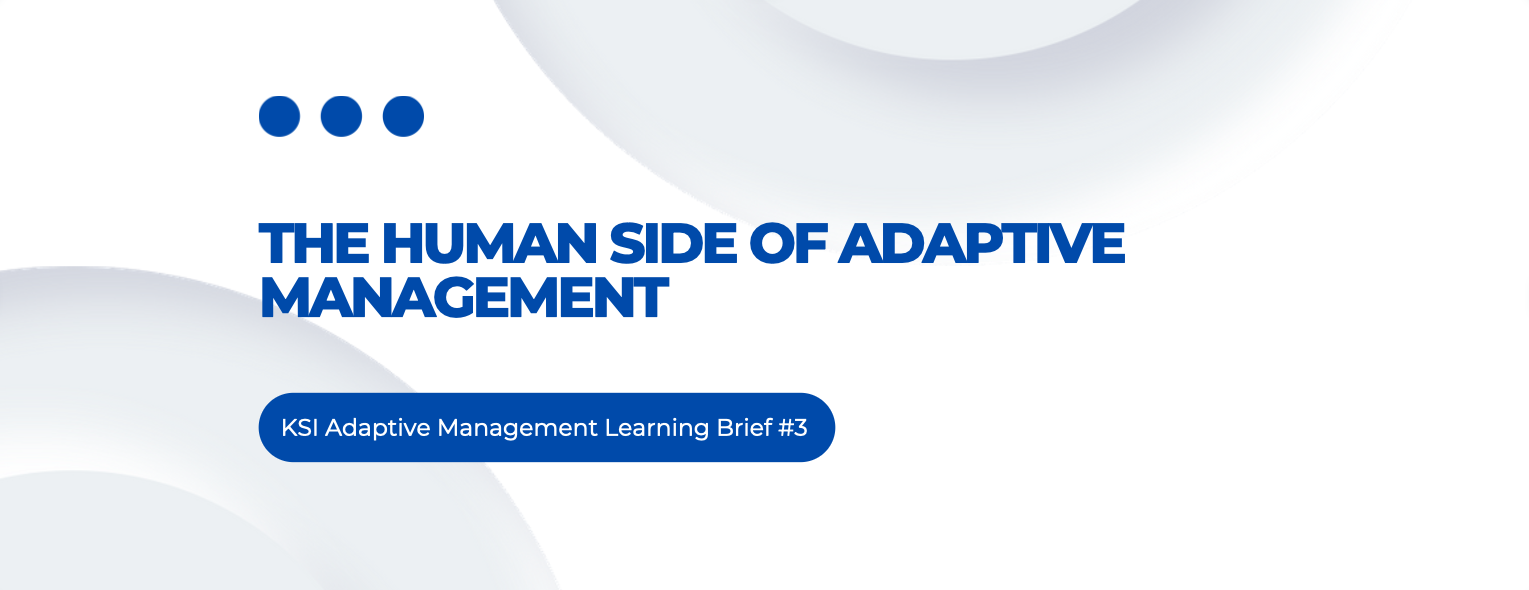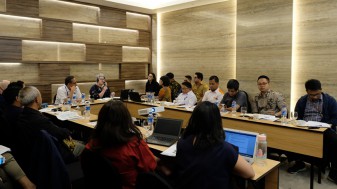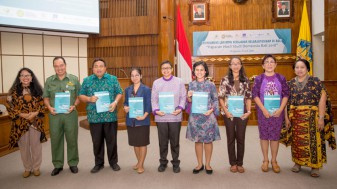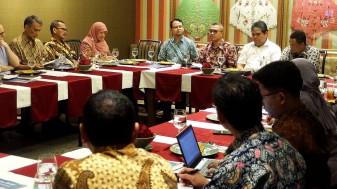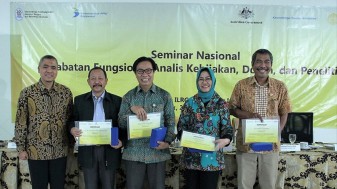KSI Adaptive Management Learning Brief #3[1]
January 2022
Introduction: The people within the system[2]
This brief is one in a series of learning documents that capture and share key lessons the Knowledge Sector Initiative (KSI) in Indonesia has learned in its efforts to implement an adaptive management approach during Phase 2 of its operations (2017-2022). These briefs are intended to be practitioner-focused and while there is some reference to the broader literature, our aim is to provide a succinct description of the KSI approach and a set of lessons we hope will be useful to others attempting to implement similar adaptive approaches.
As outlined in the summary brief and detailed in the relevant companion brief on specific systems and processes used to support adaptation, considerable attention has been paid to the development of ‘hard’ systems. There are now an increasing number of tools, templates and cases which describe a wide range of protocols.[3] Such resources are a valuable contribution and resource for those aiming to implement adaptive practices.
In our experience, systems that support regular reflection and provide a forum for decision-making, together with the freedom to adjust outputs and intermediate outcomes do provide flexibility to make changes in light of a practical reality that must be reckoned with. And yet, there is more to it than that when it comes to making adaptation work in practice. Making these changes requires managing a suite of what we might call ‘soft’ issues.
The crucial point here is these are not purely technical spaces and the process of managing a portfolio, whether through a period of consolidation, expansion or stasis, is not simply a technical process. They are personal spaces, in the sense that they are occupied and operated by real people with their own personalities and emotions. They are also political spaces, in the sense that they are spaces in which ideas and choices about the allocation of resources are contested. Each party brings their own interests, incentives and timelines to the process, and suddenly what an implementer may see as a straightforward choice to move out of the activities A and C while doubling down on activity B, becomes much harder when counterparts have other ideas or simply aren’t yet ready to make that move.
People and relationships, a brief practical description:
The importance of this softer side of adaptation arguably becomes even greater as a program involves a wider range of people. For KSI, this included not only internal program staff, but also the dense network of operational partners and counterparts the program developed over its lifespan, each of whom were therefore potentially influenced by any adaptive decision-making process:
Internal: The core KSI team was structured according to five main functions. Each of the first three would lead some areas of operations and support others, while the latter two were fully cross-cutting in their supporting roles:
- Policy and Innovation Development (PID): Responsible for convening and brokering relationships between key actors to support collective identification of problems and solutions.
- Strategic Partnership Management (SPM): Responsible for managing contracts and grants to grants to Policy Research Institutes and other projects or groups as partners.
- Knowledge Exchange and Learning (KEL): Responsible for building knowledge management capacity of external partners, conducting knowledge-sharing events, and leading on communications to all program stakeholders.
- Performance, Monitoring and Evaluation (PME): Responsible for coordinating workplan development, monitoring progress, conducting learning and evaluation activities and providing input for the adaptation of program activities.
- Operations: Responsible for supporting implementation through a range of functions including financial and human resource management.
Partnerships: In addition to full-time staff, the program relied upon a broad spectrum of national and international partners to support and deliver different parts of the program:
- 16 Policy Research Institutes involved in research and policy advocacy in Indonesia: AKATIGA, Article 33, Cakra Wikara Indonesia (CWI), CSIS, ELSAM, IRE (Institute for Research and Empowerment), KPPOD, PKMK, PPH Unika Atmajaya, PPIM, PSHK, PUSAD, Sajogyo Institute, SEKNAS FITRA, SMERU, SurveyMETER;
- Indonesia Strategic Partners: AAKI, AIPI, BaKTI, CCPHI, CIPG, The Conversation Indonesia (TCID), UI-CSGAR; and
- International partners: Australian National University, La Trobe University, Monash University, ODI, and The University of Melbourne.
External: KSI was formally governed by a three-tiered governance structure including:
- A Program Steering Committee (PSC) co-chaired by the Department of Foreign Affairs and Trade (DFAT) and Bappenas and with members consisting of Echelon 1 representatives from relevant ministries and agencies. The PSC was charged with providing strategic direction; endorsing program implementation strategies; approving the annual work plan, progress report and other strategic documents.
- A Program Technical Secretariat (PTS), as the technical advisory body co-chaired by Bappenas (at Echelon 2 level) and DFAT (at Counsellor level), with members consisting of Echelon 3 levels of relevant Bappenas directorates, relevant line ministries and agencies and representatives of KSI key partners. The PTS provided inputs for the annual work plan and recommendations to PSC for approval; provided technical oversight; and endorsed emerging priorities not listed in the approved annual work plan.
- A set of working groups (Pokja) bringing together relevant working-level counterparts in four thematic areas: Research Agenda & Funding; Research Quality; Knowledge Collaboration; and Integrated Planning & Budgeting
In addition, the hard systems and processes for adaptation described in the companion brief outline a tripartite Progress Review involving implementers, donors and government counterparts, which fed into this governance structure. In practice, these operated in something of a sequence: Learning Weeks generating findings, which were tested in working groups, presented and refined at the PTS and ultimately approved at the PSC. There were exceptions to this pattern, but the general flow indicates just how many people, priorities and opinions could influence adaptation, generating new requests, slowing down exits and occupying significant management time for the team.
Key lessons for practitioners:
In the remainder of this brief, we focus on four lessons we feel will be most useful for practitioners in ensuring the human factors influencing adaptation are identified and work to support program outcomes.
The answers to these questions will invariably depend on the specifics of the program, including the size and composition of the team and the breadth of and number of initiatives in the reform portfolio, as well as norms and expectations of what is ‘acceptable’ across different posts. Where possible seize efficiencies (e.g. ensuring indicators of progress are those teams find useful anyway), but know that in some cases, cutting resources can have implications for both process and product. There is a temptation, which can be reinforced by reporting or publication pressures, to want more: more detail, more analysis, more documentation, and so forth. But recognizing the significant demands placed on real people with lots of responsibility and limited bandwidth, there is also a real risk of reporting fatigue. Although that risk is certainly not limited to programs practicing adaptive management, the trajectory of KSI’s approach reflects this dynamic, with an initial push for ever-greater systems development and reporting eventually giving way to a need to streamline throughout the process.
- Proactively manage external expectations: Most programming that has set out to be intentionally ‘adaptive’ has put in place governance mechanisms that serve a dual purpose. Not only do they provide a forum for reflection and decision-making, but they also provide some form of oversight and accountability to the donors being asked to go along on the adaptive journey. These tend to be the formalised systems and processes focused on significant changes in the program’s portfolio of work (adaptive programming[4]), rather than the micro or day-to-day adaptation of adaptive delivery[5]. There is some interesting variation in how these are set up from program to program and as outlined above KSI’s were no doubt among the more complicated. The complexity of the program’s relationships and governance arrangements meant that a single decision to modify a workstream would not only affect the KSI team working on that initiative, but also likely involve a set of partners, many of which had working relationships codified in grant agreements or contracts, and a significant number of donor and government counterparts who had shaped, reviewed and approved that work. This wide range of relationships, which contributed to its ability to function effectively across a wide-ranging portfolio, can also generate ‘stickiness’ in adaptive processes. Managing expectations of all parties from the outset about the need to make changes or abandon non-productive strategies helps avoid that stickiness, as does the application of structured decision-making criteria to build confidence in the robustness of the process, but is no guarantee of a graceful exit. In practice, adaptation can depend as much on relationship management skills and calculated trade-offs as it does on the findings of internal strategy testing or review and reflect exercises. In KSI’s experience, this has included being flexible on the timing for phasing out and efforts to acknowledge stakeholders’ achievements.
- Managing internal fears: Things are hardly easier on the internal side. As programs make hard choices about moving out of certain areas, hard human resource questions immediately arise. In some cases, bringing a workstream to a halt can bring about potential worries about job security. In an ideal world, all staff would be easily redeployed to other roles within the team. In reality, there are limits to this interchangeability as a program seeks solutions that are not only politically feasible, but also technically sound and require specific forms of expertise. It is often simply impractical to have everyone across every piece of work. There are approaches that can help address this. While KSI structured around the five teams noted above, the program intentionally placed a clear emphasis on overcoming some of the tendencies towards siloed working observed in phase 1 and aimed for ‘talented generalists’ in its core staff by hiring for skills in network-building, facilitating collaborative processes and management rather than simply focusing on expected technical needs. This typically allowed program staff to work flexibly in roles across initiatives, while using contractors for specific technical inputs. However, even this approach has limitations. For example, every staff member brings their own passion for an issue, as well as networks and relationships, and these are not necessarily interchangeable. Further, while KSI’s different teams worked together to deliver each initiative, complementarity is not interchangeability and there remained a sense that certain workstreams were ‘owned’ by a particular team.
- Build collective ownership and depersonalize criticism: Adaptation is in many ways an exciting process, with staff creating and seizing emerging opportunities to advance elements of a reform agenda. And yet, the reality is that it is also a process that can seem harsh when changing direction can be construed as somehow having failed and at the very least generates disappointment with not being able to continue where so much time and effort have already been committed. Again, a proactive approach that builds a culture of testing that creates the expectation of change, and building collective ownership of ideas can help depersonalize the process of adaptation.[6] KSI’s process of regular collective reflection has helped with that, as did an explicit commitment to a culture of critical friendship, but it is a delicate line to tread when so many staff are emotionally invested in their work and when that commitment is something programs seek out and encourage.
- Managing time, including preparation: Systems and processes for adaptive management take peoples’ time. Focusing only on the number of hours dedicated to a learning week session itself belies the fact that the full suite of processes can require considerable effort, not only for the sessions themselves, but also for preparation and follow-up, accompanying documentation and so forth. Certainly, there are ways to be more efficient, including by avoiding duplication of processes or documentation, having good monitoring systems that accurately track a limited number of truly meaningful indicators of progress, and identifying staff with the ability to succinctly analyze strategy and who find it natural to describe progress towards outcomes rather than workplan implementation. More light-touch approaches are also possible, but these can come with trade-offs in depth, quality and the documentation often requested by partners. Those trade-offs can be particularly challenging where strategy requires more in-depth discussion and critical thinking, and where systems and processes to support learning and adaptation are also expected to serve reporting and accountability purposes. In finding the right balance practical choices to consider include:
- How frequently should structured sessions take place?
- How long do those sessions need to be?
- Who should attend each session?
- What form of documentation is necessary for different objectives?
- Who is responsible for that documentation?
- Who is responsible for preparing materials in advance (e.g. templates or surveys)?
- Who is responsible for any synthesis or analysis of existing knowledge and what depth of analysis is expected?
Together, these challenges bring issues of interpersonal skills, communication and leadership to the fore, reminding us that whatever the formal systems and processes in place, those that work within them are still human. Where these approaches work well, it is no surprise that participants are quick to point out the quality of relationships. This is not an accident, but is actively prioritised by those involved and something all of us would do well to emulate.
-----------------------------
[1] These briefs have been written by Daniel Harris with the support of the KSI Performance, Monitoring and Evaluation team, and are based on a program of action research that followed and informed the program’s adaptive management approach.
[2] Companion briefs reflect on the program’s evolving understanding of adaptation, the hard systems and processes put in place to support adaptive processes, and leadership of adaptive programs.
[3] Examples include specific tools such as Strategy Testing: An Innovative Approach To Monitoring Highly Flexible Aid Programs(Ladner, 2015); thematic guidance, such as Pasanen and Barnett’s (2019) collection on monitoring and evaluation for adaptive management; and more comprehensive 15-step toolkits (Teskey and Tyrell, 2021).
[4] Punton, M. and Burge, R. (2018) 'Adaptive Programming in Fragile, Conflict and Violence-Affected Settings. What Works and Under What Conditions? The Case of PERL, Nigeria', Case Study for the Action for Empowerment and Accountability Programme, Itad and Oxfam in association with IDS.
[5] Christie, A. and Green, D. (2018) Adaptive Programming in Fragile, Conflict and Violence-Affected Settings, What Works and Under What Conditions?: The Case of Pyoe Pin, Myanmar, Itad and Oxfam in association with IDS for the Action for Empowerment and Accountability Research Programme
[6] Cole, W., Ladner, D., Koenig, M., and Tyrrel, L. (2016) Reflections on Implementing Politically Informed, Searching Programs: Lessons for Aid Practitioners and Policy Makers. San Francisco: The Asia Foundation.

